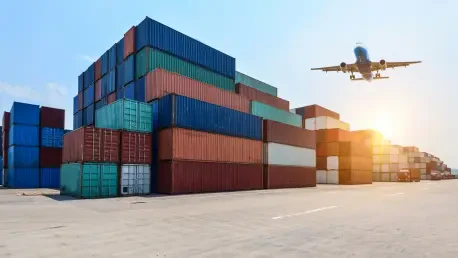Overview of the Air Cargo Industry
The air cargo sector stands as a critical artery of global trade, ensuring the swift movement of high-value goods across continents and fueling the explosive growth of e-commerce. With the ability to deliver time-sensitive shipments like pharmaceuticals, electronics, and perishable items, this industry underpins supply chains that span the globe. In the U.S., air cargo contributes significantly to economic vitality, connecting domestic markets to international hubs and supporting millions of jobs in logistics and related fields.
Diving deeper, the industry comprises distinct segments such as express delivery for urgent shipments, freight forwarding for complex logistics, and the use of dedicated freighters alongside passenger belly cargo for bulk transport. Major players dominate this landscape, including cargo airlines, global logistics providers, and e-commerce giants that rely heavily on air transport for rapid fulfillment. Technological advancements have further transformed operations, with real-time tracking and supply chain integration enhancing efficiency and transparency at every step.
Yet, external forces like regulatory frameworks and trade policies exert a profound influence on the sector’s trajectory. Shifts in government mandates can alter cost structures, disrupt established routes, and reshape market dynamics overnight. As a cornerstone of international commerce, the air cargo industry remains acutely sensitive to such changes, setting the stage for the challenges currently unfolding under new U.S. trade directives.
Impact of Recent U.S. Trade Policies on Air Cargo Volumes
Key Policy Changes and Their Immediate Effects
Recent U.S. trade policies have unleashed a storm of disruption across the air cargo sector, with sweeping changes reshaping the flow of goods. The elimination of the $800 de minimis exception, which once allowed low-value imports to bypass tariffs, has struck a heavy blow to e-commerce air shipments. This policy shift has throttled the volume of small, direct-to-consumer packages that previously moved freely into the country.
Compounding the issue, the Trump administration’s announcement of heightened tariffs on Chinese goods in April has deepened the impact. These tariffs have driven a staggering decline in U.S.-China cargo volumes, with reductions reaching up to 60% on key routes. E-commerce bookings alone plummeted by 50% in May, while trans-Pacific freighter arrivals have dropped by 30% since the policy’s introduction, painting a grim picture of immediate fallout.
Beyond specific trade lanes, the broader U.S. air cargo market has suffered a 25% year-over-year volume decrease, reflecting the widespread ripple effects of these measures. Businesses dependent on rapid air transport now face higher costs and logistical hurdles, forcing a reevaluation of long-standing operational models. This sharp downturn signals a critical juncture for an industry already navigating tight margins and complex global networks.
Market Data and Growth Projections
Quantitative insights underscore the severity of the current downturn in air cargo, with industry reports revealing stark declines across major metrics. Data highlights not only the overall 25% drop in U.S. volumes but also route-specific impacts, particularly on trans-Pacific corridors where activity has significantly contracted. These figures reflect a market reeling from sudden policy-induced constraints.
The International Air Transport Association (IATA) has revised its growth forecast for the current year, slashing expected expansion from 5.8% to near-zero, a dramatic pivot from the 12% growth recorded last year. This bleak outlook suggests prolonged stagnation, with implications for fleet planning as airlines hesitate to invest in new capacity. Network operations and financial performance are also under strain, with reduced revenues threatening long-term stability.
Looking ahead, sustained policy pressures could further dampen market trends, potentially locking the industry into a cycle of diminished demand. Analysts caution that without relief or adaptation, the coming years may see continued erosion of key trade lanes. This uncertainty challenges stakeholders to rethink strategies in an environment where growth once seemed assured.
Challenges Facing the Air Cargo Sector
The air cargo industry grapples with a host of obstacles stemming from recent trade policies, creating a climate of uncertainty. Ongoing tariff disputes cloud supply chain planning, as businesses struggle to predict costs and delivery timelines amid fears of retaliatory measures from other nations. This unpredictability hampers the ability to make informed, long-term decisions.
Operationally, the sector faces price volatility that disrupts budgeting, alongside the need for extensive route overhauls to circumvent tariff-heavy corridors. Rising customs costs add another layer of financial pressure, squeezing margins for cargo airlines and freight forwarders alike. These challenges collectively strain resources, forcing companies to adapt under increasingly difficult conditions.
Moreover, a noticeable shift is underway as e-commerce leaders pivot from air to bulk sea freight, complemented by U.S.-based warehousing to sidestep air transport expenses. This trend further depresses demand for air cargo services, pushing the industry toward innovative solutions like shipment consolidation and hybrid air-ocean models. Leveraging lower fuel prices offers some cost relief, but such measures may only partially offset the deeper structural issues at play.
Regulatory Landscape and Compliance Pressures
Trade policies and regulatory shifts are fundamentally altering the operational framework for air cargo, with far-reaching consequences. The removal of the de minimis exception and the spike in tariffs signal a broader U.S. effort to recalibrate international trade dynamics, prioritizing domestic interests over unfettered import flows. These changes reflect a strategic push to reshape how goods enter the market, impacting every link in the supply chain.
Compliance now poses a significant burden, as cargo airlines and freight forwarders navigate heightened customs scrutiny and associated costs. Adapting to stricter documentation and processing requirements demands additional resources, diverting focus from core operations. The risk of non-compliance carries hefty penalties, adding to the operational strain felt across the sector.
Looking forward, the potential for further regulatory adjustments looms large, with industry advocates hoping for exemptions or policy reversals to ease the pressure. Security measures and international trade agreements also play a role, influencing market access and operational protocols. How these elements evolve will likely determine whether the industry can find a path to stability amid the current turbulence.
Future Outlook for Air Cargo Amid Trade Uncertainties
As trade uncertainties persist, the air cargo industry must chart a course through untested waters, exploring new strategies to mitigate risks. Partnerships with countries offering reduced tariffs present one avenue, allowing operators to diversify freight routes and tap into alternative markets. Such collaborations could help offset losses from heavily taxed trade lanes, providing a lifeline for struggling firms.
Innovation also holds promise, with premium pricing models for high-value cargo gaining traction as a way to sustain revenue streams. Technology-driven efficiency gains, from automated sorting to predictive analytics, offer another means to cut costs and enhance service reliability. These advancements could position forward-thinking companies to weather the storm more effectively than their competitors.
Yet, potential disruptors like retaliatory tariffs and shifting consumer preferences toward slower, cheaper shipping options threaten to undermine progress. Broader economic factors, including fuel price fluctuations and ongoing global trade negotiations, will also shape recovery prospects. The balance of these forces will influence freighter demand, fleet conversions, and long-term network planning, with the industry at a pivotal moment of adaptation or decline.
Conclusion and Strategic Recommendations
Reflecting on the profound disruptions that have shaken the air cargo sector, it has become evident that U.S. trade policies have carved a deep impact, slashing volumes and dimming near-term prospects. The dramatic declines and revised forecasts paint a challenging picture, yet the industry’s response reveals a capacity for resilience through tactical shifts and innovative thinking.
Moving forward, stakeholders should prioritize actionable steps to navigate the lingering uncertainty. Exploring untapped markets in regions less affected by tariffs could unlock new growth opportunities, while advocating for policy relief might ease regulatory burdens. Investing in technology to streamline operations and reduce costs emerges as a critical focus, ensuring competitiveness in a tightened market.
Additionally, fostering hybrid shipping models that blend air and ocean transport offers a practical solution to balance speed and expense. As potential trade agreements loom on the horizon, maintaining agility to capitalize on favorable shifts stands out as essential. These strategies, if pursued with diligence, hold the promise of guiding the industry toward a steadier footing in an unpredictable global landscape.









